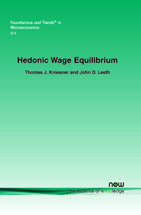Hedonic Wage Equilibrium: Theory, Evidence and Policy
By Thomas J. Kniesner, Syracuse University, USA and IZA, Germany, tkniesne@maxwell.syr.edu | John D. Leeth, Bentley University, USA, jleeth@bentley.edu
Abstract
We examine theoretically and empirically the properties of the equilibrium wage function and its implications for policy. Our emphasis is on how the researcher approaches economic and policy questions when there is labor market heterogeneity leading to a set of wages. We focus on the application where hedonic models have been most successful at clarifying policy relevant outcomes and policy effects that of the wage premia for fatal injury risk.
Estimates of the overall hedonic locus we discuss imply the so-called value of a statistical life (VSL) that is useful as the benefit value in a cost-effectiveness calculation of government programs to enhance personal safety. Additional econometric results described are the multiple dimensions of heterogeneity in VSL, including by age and consumption plans, the latent trait that affects wages and job safety setting choice, and family income.
Simulations of hedonic market outcomes are also valuable research tools. To demonstrate the additional usefulness of giving detail to the underlying structure we not only develop the issue of welfare comparisons theoretically, but also illustrate how numerical simulations of the underlying structure can also be informative. Using a reasonable set of primitives we see that job safety regulations are much more limited in their potential for improving workplace safety efficiently compared to mandatory injury insurance with experience rated premiums. The simulations reveal how regulations incent some workers to take more dangerous jobs, while workers' compensation insurance does not (or less so).
Hedonic Wage Equilibrium
Hedonic Wage Equilibrium examines empirically and theoretically the properties of the equilibrium wage function. Section 1 presents the complete economic structure of the hedonic labor market equilibrium model and considers the possibility of multiple hedonic equilibrium loci for highly distinctive groups of workers such as smokers and nonsmokers and the hedonic locus for desirable workplace attributes. Section 2 describes the precision one can bring to policy evaluations with the hedonic equilibrium locus. The reader interested mainly in learning the fundamentals of hedonic equilibrium can focus on Sections 1 and 2 only. Complementing Section 2, Section 3 describes the special econometric issues involved with estimating the hedonic locus and the underlying structure resulting from worker and firm heterogeneity and the implicit prices of workplace characteristics that are the fundamental ingredients to an hedonic equilibrium econometric model. The reader who is knowledgeable in the theoretical dimension of hedonic equilibrium, but who wants to learn the econometric nuances of the model, can focus on Section 3. Section 4 presents recent empirical results for the hedonic wage equilibrium locus and their implications for policy that use the value of a statistical life (VSL), which is the implicit value workers as a group place on one life. Section 4 is a standalone presentation that may be the primary interest of readers knowledgeable in how to estimate hedonic equilibrium regression models but want to learn some useful recent econometric results. Econometric estimates are not the only way to give empirical content to the hedonic model. In Section 5 we present the empirical alternative of numerical simulation, which may be the focal section for readers well versed in the theory and econometrics but wish to expand their knowledge base to include the technique of computable hedonic equilibrium. Our results show the relative dominance of workers' compensation insurance over occupational safety and health regulations in improving workplace safety. Section 6 presents the conclusions.
